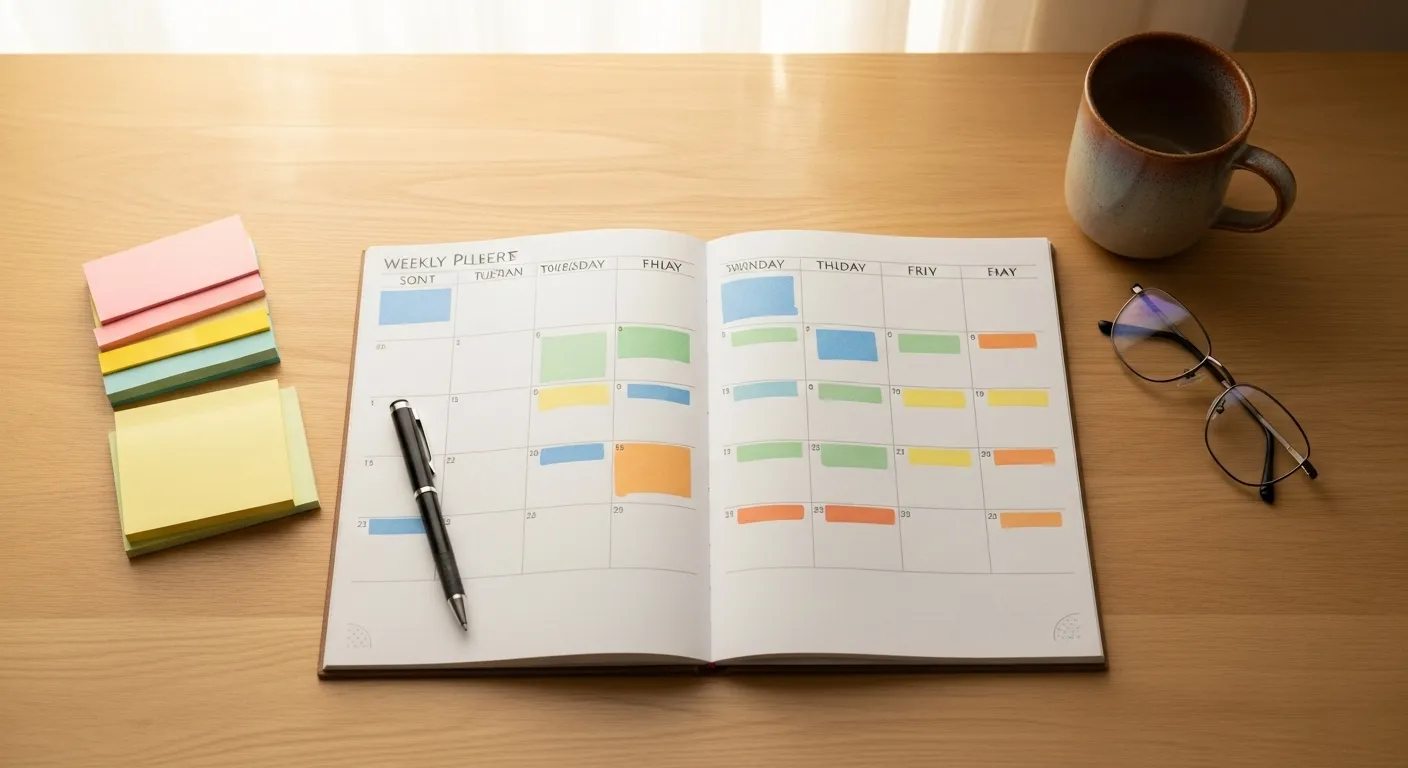
You’ve seen them on social media. A beautiful collage of inspiring images, powerful quotes, and dreamy destinations. The vision board promises a future of abundance, success, and happiness. You spend a weekend cutting out pictures from magazines, printing inspiring photos, and carefully arranging them into a masterpiece of motivation. You hang it in a prominent place, feeling a surge of excitement. This is the year it all changes.
Then, weeks turn into months. The board, once a beacon of possibility, starts to blend into the background. The initial excitement fades, replaced by a nagging sense of guilt. The dreams pinned to the corkboard feel just as distant as they did before. Why? Because a collection of wishes is not a plan. A vision board fails when it’s treated as a magical artifact instead of the first step in a practical, strategic process. The problem isn’t the vision; it’s the absence of a bridge between that vision and your daily life.
Vague goals like “be healthier,” “get a better job,” or “be more creative” are impossible to act on because they lack clarity. They don’t tell you what to do at 8 AM on a Tuesday. This ambiguity leads to procrastination, overwhelm, and eventually, abandonment. The goal isn’t to stop dreaming big. The goal is to build a system that translates those big dreams into small, consistent, and measurable actions. It’s about creating a clear line of sight from your ultimate destination to the very next step you need to take.
At TheFocusedMethod.com, we believe that follow-through is a skill, not a personality trait. It’s built through clarity and cadence. In this article, we’ll move beyond the glitter and glue to show you how to create a vision board that actually works. We will give you a practical framework to connect your highest aspirations to a repeatable system of progress tracking, turning your board from a passive decoration into an active roadmap for your life.
📚 Table of Contents
- From Abstract Vision to Concrete Action: The Four-Tier Model
- Tier 1: The Big Vision (Your “Why”)
- Tier 2: Quarterly Themes (Your “What”)
- Tier 3: Weekly Focus (Your “How”)
- Tier 4: Daily Actions (Your “Do”)
- Measurement: How to Know If You’re Actually Making Progress
- Choosing Your Metrics: Input vs. Output Goals
- The Review Cadence: Creating a Feedback Loop
- How to Handle Slip-Ups and Setbacks
- Practical Planning: Weaving Your Goals into Your Real Life
- Time Blocking: Give Your Goals a Home in Your Calendar
- Checkpoints and Milestones: Building Momentum
- Constraint-Aware Planning: Acknowledging Reality
- Worked Examples: Putting the Method into Practice
- Frequently Asked Questions (FAQ)
- What if I have too many goals on my vision board?
- How do I handle conflicting priorities, like a demanding job and a personal goal?
- I’m just not feeling motivated. What should I do?
- My goal is ambiguous, like “be more creative.” How do I pick a metric?
- Is this just a glorified to-do list? What’s the point of the vision board?
- Conclusion: From Dreaming to Doing
From Abstract Vision to Concrete Action: The Four-Tier Model
The secret to an effective vision board lies in deconstruction. You must break down your grand vision into progressively smaller, more manageable units of effort. Think of it as a pyramid. At the top is your inspiring vision, and at the base are the daily actions that support it. Each level connects logically to the one above it. This model provides the structure needed to ensure your daily efforts are always aligned with your long-term goals.
Tier 1: The Big Vision (Your “Why”)
This is the traditional vision board. It’s the emotional and inspirational core of your entire plan. This is where you allow yourself to dream without limits. What do you want your life to look, feel, and be like in one to three years? Collect images, words, and symbols that represent this future state. Focus on the feeling, not just the objects. Instead of just a picture of a new house, find an image that evokes the feeling of “home,” “security,” or “family gatherings.”
Crucially, you must articulate the why behind each image. If you have a picture of someone running a marathon, is your “why” about physical health, mental resilience, or the sense of accomplishment? Write it down. Your “why” is the fuel that will get you through the inevitable dips in motivation. This vision isn’t the plan itself; it’s the North Star that keeps your plan oriented in the right direction.
Tier 2: Quarterly Themes (Your “What”)
Looking at a three-year vision can be paralyzing. The next step is to break it down into 90-day focus areas, or “themes.” A quarter is the perfect time horizon—long enough to make significant progress, but short enough to maintain focus and urgency. Look at your big vision and ask, “What is the most important area to focus on for the next 90 days to move me closer to this vision?”
You might have several goals, but try to limit your themes to one or two per quarter to avoid spreading yourself too thin. Examples of quarterly themes could be: “Career Launch,” “Financial Foundation,” “Health Reset,” or “Creative Exploration.” A theme like “Financial Foundation” gives you a clear direction. It tells you that for the next 12 weeks, your primary goal-oriented energy will be dedicated to activities related to improving your financial situation.
Tier 3: Weekly Focus (Your “How”)
This is where your abstract theme becomes a concrete plan. Each week, you will define a small number of specific objectives that support your quarterly theme. This is the perfect place to introduce established goal-setting frameworks like SMART goals or OKRs (Objectives and Key Results).
A SMART goal is Specific, Measurable, Achievable, Relevant, and Time-bound. For the theme “Health Reset,” a vague goal is “eat better.” A SMART goal is: “For the next seven days, I will eat a vegetable with every lunch and dinner.” It’s crystal clear what success looks like.
OKRs offer a slightly different structure. An Objective is what you want to achieve (the inspirational “what”), and Key Results are how you’ll measure it (the metric-driven “how”). For a “Career Launch” theme, an OKR might be:
Objective: Master the fundamentals of a new software program.
Key Results:
- Complete 50% of the online certification course.
- Build a small project using the software’s core features.
- Spend 5 hours in focused practice sessions.
Your weekly focus should consist of 1-3 such objectives. This prevents overwhelm and ensures you are channeling your efforts effectively.
Tier 4: Daily Actions (Your “Do”)
Finally, we arrive at the foundation of the pyramid: daily actions. Your weekly objectives must be broken down into specific tasks you can execute each day. If a weekly key result is to “spend 5 hours in focused practice,” your daily action for Monday might be “Block 60 minutes from 7 PM to 8 PM for software practice.”
This is where the concept of a “done list” becomes incredibly powerful. Instead of starting your day with a daunting to-do list, end your day by writing down what you accomplished that moved you toward your goal. This shifts your focus from a sense of endless tasks to a feeling of accomplishment and progress. Seeing a growing “done list” of goal-aligned actions provides a powerful hit of motivation and reinforces the habit of execution. It proves to you, day by day, that you are the kind of person who follows through.
![]()
Measurement: How to Know If You’re Actually Making Progress
“What gets measured gets managed.” This old adage is the cornerstone of turning a vision into reality. Without measurement, you’re flying blind. You have no way of knowing if your actions are effective, where you’re falling short, or when you need to adjust your strategy. A functional vision board system requires a simple, consistent method for progress tracking.
Choosing Your Metrics: Input vs. Output Goals
Most people naturally set output goals. These are goals focused on the result you want to achieve. Examples include “lose 10 pounds,” “earn a promotion,” or “run a 5k.” The problem with only tracking outputs is that you don’t have direct, immediate control over them. You can’t force your body to lose a pound tomorrow. This lack of control can be demotivating.
The solution is to focus on input goals. These are the actions you can control that lead to the desired output. For the output goal of “lose 10 pounds,” your input goals could be “exercise 3 times a week” and “eat 5 servings of vegetables daily.” You have 100% control over whether you put on your running shoes or add broccoli to your plate.
This is also known as the difference between lagging indicators and leading indicators. A lagging indicator (the output) tells you what has already happened (e.g., the number on the scale). A leading indicator (the input) is predictive; it measures the actions that will likely cause the lagging indicator to change. Your progress tracking system should be overwhelmingly focused on leading indicators. Did you do the thing you said you would do? Yes or no. This binary, controllable measurement is the key to building momentum.
The Review Cadence: Creating a Feedback Loop
A plan is just a guess. You need a regular cadence for reviewing your progress and adjusting your plan based on real-world data. A complex review process will be abandoned, so keep it simple.
The Daily Check-in (2 Minutes): At the end of each day, look at your plan. Did you complete your intended action? Mark it on your “done list.” If not, why? This isn’t about judgment; it’s about gathering information.
The Weekly Review (15-30 Minutes): Once a week, perhaps on a Sunday evening, review your progress toward your weekly objectives. Celebrate your wins—what went well? Analyze the misses—what got in the way? Was the goal too ambitious? Did an unexpected event derail you? Use this information to set realistic objectives for the upcoming week. This is your primary course-correction meeting with yourself.
The Quarterly Reset (1-2 Hours): At the end of each 90-day cycle, take a step back. Look at your big vision board. Review your progress on your quarterly theme. Did you achieve what you set out to do? What did you learn? Based on this review, choose your theme for the next quarter. This ensures your plan stays agile and relevant to your evolving life and priorities.
How to Handle Slip-Ups and Setbacks
You will miss a day. You will have a bad week. It is inevitable. The difference between a system that works and one that fails is how you respond to these moments. Perfection is not the goal; consistency is. If you view a missed workout as a total failure, you’re more likely to give up entirely. This is known as the “what-the-hell effect.”
Instead, treat setbacks as data points. If you consistently fail to achieve a weekly goal, the problem isn’t your willpower; it’s your plan. The goal might be too large, the time you allocated might be insufficient, or the strategy itself might be flawed. Use your weekly review to diagnose the issue. Maybe you need to break the goal into even smaller steps. Maybe you need to schedule it for a different time of day when you have more energy. By treating setbacks as feedback, you transform them from sources of shame into opportunities for learning and refinement.

Practical Planning: Weaving Your Goals into Your Real Life
A brilliant plan is useless if it only exists on paper. To make your vision board system work, you must integrate your goal-oriented actions into the fabric of your daily life. This requires proactive planning and a realistic understanding of your own limitations and environment.
Time Blocking: Give Your Goals a Home in Your Calendar
Hope is not a strategy. If your plan is to “find time” to work on your goals, you will consistently fail. More urgent, but less important, tasks will always crowd out your time. The solution is time blocking. You must treat appointments with your goals with the same seriousness as a doctor’s appointment or a meeting with your boss.
Open your calendar during your weekly review and schedule specific blocks of time for your daily actions. If your goal is to write for 30 minutes, put a 30-minute block on your calendar every morning. This does two things. First, it forces you to confront the reality of your schedule and make conscious trade-offs. Second, it removes the friction of in-the-moment decision-making. When the calendar alert pops up, you don’t have to debate whether you should work on your goal. The decision has already been made. Your only job is to execute.
Checkpoints and Milestones: Building Momentum
Long-term goals can feel daunting. A quarterly theme, while better than a three-year vision, can still feel far away. To maintain motivation, build smaller checkpoints and milestones into your plan. These are mini-celebrations that acknowledge your progress along the way. If your quarterly theme is “Financial Foundation” and your goal is to save $1,200, don’t wait until the end to feel good about it. Set milestones at $400 and $800. When you hit them, acknowledge the achievement. This could be as simple as making a note in your journal or treating yourself to a coffee.
These checkpoints create a positive feedback loop. Each milestone you reach reinforces your belief in your ability to succeed, which in turn fuels your motivation to tackle the next phase of the goal. It breaks a monolithic challenge into a series of achievable wins.
Constraint-Aware Planning: Acknowledging Reality
Many goal-setting systems fail because they are designed for a perfect, friction-free world. Your world is not like that. You have a job, a family, limited energy, and unexpected events that disrupt your plans. A constraint-aware plan is one that acknowledges these realities from the outset.
Before you finalize your weekly objectives, ask yourself: What are my constraints this week? Do I have a major work deadline? Are the kids home from school? Am I feeling tired or burned out? Your plan must be flexible enough to accommodate these realities. On a high-energy, low-stress week, you might be able to schedule five workout sessions. On a chaotic, high-stress week, aiming for two sessions might be a more realistic and sustainable goal. Setting a goal you can actually achieve, even if it’s smaller, is infinitely better for your long-term motivation than setting an ambitious goal and failing. Be honest with yourself about your capacity, and build a plan that works for the life you have, not the one you wish you had.

Worked Examples: Putting the Method into Practice
Let’s move from theory to application. Here are two common scenarios, showing how this structured approach transforms a vague desire into a clear, actionable plan.
Scenario 1: The Career Pivot
The Person: Sarah, a marketing coordinator who feels unfulfilled and wants to transition into a more creative and technical role as a UX (User Experience) designer.
Tier 1: The Big Vision Board. Sarah’s board is filled with images of people collaborating in modern offices, sleek app interfaces, and quotes about creativity and problem-solving. Her “why” is to have a career that engages her analytical mind and creative spirit, offering better long-term growth and financial stability.
Tier 2: Quarterly Theme. Staring at the board, Sarah realizes the first step is acquiring the necessary skills. Her theme for the first quarter is “Foundational Skills Acquisition.” This single focus prevents her from getting distracted by networking or portfolio building before she’s ready.
Tier 3: Weekly Focus (OKR Format). For the first week of her “Foundational Skills” quarter, Sarah sets a clear objective:
Objective: Begin my online UX certification course with strong momentum.
Key Results:
- Watch and take notes on the first three video modules.
- Complete the introductory project on user personas.
- Dedicate four hours of focused study time.
Tier 4: Daily Actions. Sarah looks at her Key Results and her calendar. She time-blocks one hour every evening from Monday to Thursday for “UX Study.” Her daily action is simple: When the 8 PM calendar reminder appears, she opens her laptop and starts the next lesson. On Friday, she reviews her “done list” for the week: “Completed 4 study hours. Finished 3 modules. Drafted user personas.” She has met her goal and feels a sense of accomplishment.
Measurement: Sarah tracks her leading indicator: hours studied (input). She knows that if she consistently hits her input goal, the course completion percentage (the lagging indicator) will take care of itself. If she has a busy week and only manages two hours, she doesn’t quit. In her weekly review, she adjusts next week’s plan to be more realistic, perhaps aiming for three hours instead of four.
Scenario 2: The Fitness Goal
The Person: Mark, who wants to improve his cardiovascular health and has a goal of running a 5k race in four months.
Tier 1: The Big Vision Board. Mark’s board has a picture of a 5k finish line, people looking energetic and happy outdoors, and a printout of healthy-looking meals. His “why” is not just about the race; it’s about having more energy to play with his kids and feeling better in his own body.
Tier 2: Quarterly Theme. For the first 90 days, Mark knows he needs to build a solid base. His theme is “Consistent Conditioning.” The goal isn’t speed or distance yet; it’s simply about establishing the habit of running regularly without injury.
Tier 3: Weekly Focus (SMART Goal Format). Using a beginner 5k training plan, Mark sets his goal for Week 2: “This week, I will complete three run/walk sessions as prescribed by my training plan, totaling at least 30 minutes of activity per session.” This goal is Specific (three run/walks), Measurable (3 sessions), Achievable (it’s a beginner plan), Relevant (to his theme), and Time-bound (this week).
Tier 4: Daily Actions. Mark schedules his runs on his calendar for Monday, Wednesday, and Friday mornings before work. His daily action on those days is simple: “Put on running clothes and go outside.” He knows that starting is the hardest part. He doesn’t worry about the full 30 minutes; he just focuses on the first five. By the end of the week, his “done list” shows three completed workouts.
Measurement: His primary metric is a leading indicator: “Number of workouts completed per week.” His goal is 3 out of 3. This is a simple, controllable yes/no metric. He also tracks his distance and time, but he sees those as secondary, lagging indicators. The main thing is showing up. If he gets sick and misses a run, he doesn’t see it as a failure. During his weekly review, he adjusts the following week’s plan to ease back into it, ensuring he doesn’t push too hard and risk injury.

Frequently Asked Questions (FAQ)
What if I have too many goals on my vision board?
This is a very common issue. A vision board should be expansive, but your action plan must be focused. The quarterly theme system is designed to solve this. Look at your board and group your goals into categories (e.g., Career, Finance, Health, Relationships). Then, ask yourself the critical question: “Which one of these areas, if I made significant progress in it over the next 90 days, would have the greatest positive impact on my life?” Choose that one area as your primary theme. You can have a secondary, lower-intensity theme if you feel you have the capacity, but one is often best. The other goals aren’t gone; they are simply waiting for their turn in a future quarter.
How do I handle conflicting priorities, like a demanding job and a personal goal?
This comes down to constraint-aware planning and the principle of integration. First, acknowledge the conflict. Your job is a real and important constraint. Your plan must respect it. This means setting smaller, more realistic input goals. Instead of trying to write a book for an hour every day, maybe your goal is to write for 15 minutes. Second, look for ways to integrate goals. If a health goal is to be more active and a family goal is to spend more quality time, could you combine them with a family walk or bike ride after dinner? Don’t view your life as a series of competing buckets; see it as a single system you can optimize.
I’m just not feeling motivated. What should I do?
Motivation is fickle; it comes and goes. A robust system works even when motivation is low. First, revisit your “why.” Look at your vision board and reconnect with the feeling you are trying to create. Second, and more importantly, shrink the action. If you don’t feel motivated to go for a 30-minute run, is there enough motivation to put on your running shoes? Often, the motivation appears after you start, not before. Focus on the smallest possible first step. Finally, rely on your “done list.” Look back at the progress you’ve already made. This can provide the proof you need that you are capable and that your small efforts are adding up.
My goal is ambiguous, like “be more creative.” How do I pick a metric?
You must translate the ambiguous into the concrete. “Be more creative” is a wonderful vision, but it’s not an actionable goal. Ask yourself: “What are the actions a creative person takes?” They might write, draw, play music, or brainstorm ideas. Now, turn those actions into a measurable input goal. “Be more creative” becomes “Write 100 words every day” or “Spend 15 minutes sketching three times a week.” You aren’t measuring creativity itself (a lagging indicator), but you are measuring the behaviors that lead to it (leading indicators). Track the inputs, and the outputs will follow.
Is this just a glorified to-do list? What’s the point of the vision board?
A to-do list tells you what to do. A vision board system tells you why you’re doing it. The vision board is the source of intrinsic motivation. The daily actions and weekly goals are the execution engine. Without the vision, the daily actions can feel like a grind, and it’s easy to lose sight of the bigger picture and quit. Without the action plan, the vision remains a daydream. This method links the two, ensuring that your daily checklist is always in service of your most meaningful, long-term aspirations. It’s the connection between the two that creates sustainable, fulfilling progress.
Disclaimer: The information provided in this article is for informational purposes only and is not intended as a substitute for professional medical, financial, or legal advice. Always seek the advice of a qualified professional with any questions you may have regarding a medical condition, financial situation, or legal matter.

Conclusion: From Dreaming to Doing
A vision board that works is not a static object of desire; it is a dynamic tool for focus. It’s the beautiful cover of a very practical playbook for your life. The magic isn’t in the images themselves, but in the structured process that connects those images to your calendar. By translating your grand vision into quarterly themes, weekly objectives, and daily, controllable actions, you build a reliable bridge between the person you are today and the person you aspire to be.
Progress isn’t born from a single moment of inspiration but from the aggregation of small, consistent efforts over time. It’s about tracking your inputs, reviewing your progress honestly, and adjusting your plan with self-compassion. This is how you build momentum. This is how you create real, lasting change.
Don’t let your dreams remain dreams. You have the capacity to make them real, and the process starts now, with a few simple decisions. Here is what you can do today to get started:
1. Clarify One Vision: Write down one important goal or area of your life you want to transform. Describe what it will look and feel like when you are successful. This is the seed of your vision.
2. Define a 90-Day Theme: Based on that vision, what is a logical theme for the next 90 days? Give it a name, like “Health Foundation” or “Skill Building.” This provides immediate focus.
3. Schedule Your First Weekly Review: Open your calendar right now and schedule a recurring 30-minute appointment with yourself for the same time each week. Title it “Weekly Goal Review.” This is the most critical step—it builds the system.
Your future is not a matter of chance; it’s a matter of choice and action. Start today.
For expert guidance on productivity and focus, visit National Institutes of Health (NIH), National Sleep Foundation and American Institute of Stress.





